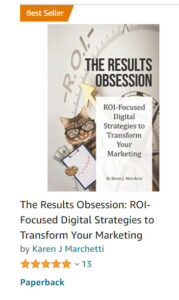When you create your website copy, those who need to approve that copy will almost always read line-by-line, word-for-word, from page 1 of the copy through to the end (like they’re reading a book).
But website visitors rarely (if ever) do that. In fact, website visitors first scan the page they’re on — and about 85% of visitors will only scan.
Few (if any) website visitors will visit every page on your site. And it’s also true that few will click on each of your menu options in order.
That means that virtually no one will read your website copy the way you (and your bosses) have — like you’re reading a book.
If you include your key points of differentiation only on your home page — or maybe on your home page and on your “About Us” page, but nowhere else — this is highly likely to happen:
- A huge percentage of your visitors will never learn the answer to the key question, “why should I buy from you?”
That means a large percentage of the money you’ve spent driving traffic, leads, and potential customers to your site will also be wasted. So how should website copy be crafted? And if 85% of visitors are only going to scan, how will they ever learn what you’re all about?
Develop Your Message Strategy — Answer “Why Should I Buy from YOU”
Before you develop your website copy, you should develop your overall positioning — your key messaging that will differentiate you from the competition. That key messaging that should be woven throughout your site. You should include it on most pages, and feature it in headlines and subheads and bullet points. Why?
- The majority of visitors will scan first. Be sure the scanning reader gets your key messages. Most visitors to your home page are scanning, rather than reading word-for-word. If you present visitors with engaging, intriguing, and/or benefit-laden headlines, subheads, bullet points, and photo captions (all of the elements that stand out to the scanning reader), you will catch their attention.
Visitors to interior pages may also start by scanning the page. So when you write your headlines and subheads, they should:
- Tell the visitor what they’ll learn on the page
- Give the visitor a reason to stay on the page to read further
- Summarize your key points of differentiation, as well as the key points you want the visitor to learn on the page
If I just read your headlines and subheads on a page, I should learn why you’re different, and what great information I can learn if I keep reading.
- You can’t predict the path of visitors. If you have to rely on visitors reading a few key pages on your website to get your key points of differentiation, you could be in trouble. What if the majority of visitors never visit those key pages?
If you bury your key points of differentiation only on your “About Us” page, how much business could you be missing? (Easy way to find out: Look at the number of unique visitors to your About Us page as a percentage of total unique visitors to your site.)
- What if only 20% of all your unique visitors ever go to About Us? That means 80% of your potential customers don’t learn your key points of differentiation. And so you’re wasting 80% of your prospecting budget.
What if you include your key points of differentiation on your home page? How much time is the average visitor spending on your home page?
Does it really seem like they’re reading the content on your home page?
The solution is not to write your website copy like you’re writing a book. If you were writing a book, you’d assume readers had read page 1 before they moved on to page 2. But websites don’t work that way.
Effective websites weave their key points of differentiation throughout the entire website. This helps to reinforce your positioning, and gives each visitor maximum exposure to the answer to “why should I buy yours?”
When advertisers run brand-building campaigns in major media (TV, magazine, newspaper, etc.), one of the keys to getting the points of differentiation across is repetition. It’s why many consumer brands create jingles — they want to create something memorable that can be used over and over in their major media campaign.
Repetition of your key points of differentiation is not overkill. Remember, you are likely one of the few who will ever read your web site page-by-page, word-for-word. You can’t assume your visitors will “get it” if your key messaging only appears on a few pages.
 Excerpted from one of the 5 copywriting chapters in our new BEST SELLER, “The Results Obsession: ROI-Focused Digital Strategies to Transform Your Marketing,” now available on Amazon.
Excerpted from one of the 5 copywriting chapters in our new BEST SELLER, “The Results Obsession: ROI-Focused Digital Strategies to Transform Your Marketing,” now available on Amazon.
Learn more about The Results Obsession book, get chapter excerpts to download, and see the Table of Contents.






“great advice Karen . . .”